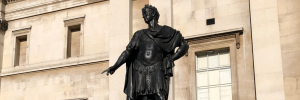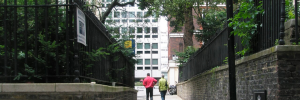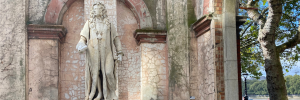London’s first coffeehouse was founded in 1652 by the churchyard of St Michael’s, Cornhill. It was not quite the first coffeehouse in England, which had been founded in Oxford two years earlier, and it was not really a coffeehouse – more of a coffee shack. Business blossomed for the man behind it, Pasqua Rosee, and soon he was selling 600 dishes a day. From this start, the capital had acquired several hundred coffeehouses by the turn of the century, a development which set London apart from other cities. London’s rivals had them, but apart from Constantinople, they did not have very many. Amsterdam, for example, had just 32.
The City accounted for the greater part of the capital’s establishments, and within the City the area around the Royal Exchange, stood out, especially the area immediately to the south-east, to the north and south of Lombard Street. The coffeehouses in the City tended to have a commercial orientation and many were patronised by merchants who had in common trade with a particular area. Helpfully, they usually made this clear in their names. Near the Exchange there could be found: the New England, Virginia, Carolina, and East India coffeehouses. Pasqua Rosee’s shack later became the Jamaica. Round the corner from it was the Jerusalem, and on Cornhill itself was the Barbados.
There were also two coffeehouses that focused directly on commercial ends: Lloyds, and Jonathans. Loyd’s initially opened on Great Tower Street, and later moved to Lombard Street in 1691. Its site is now marked by a blue plaque on a Sainsbury’s convenience store. Llloyd’s was a place where ships were auctioned, and maritime insurance arranged. Armed with enough money you could go into Lloyds and insure part of a ship, typically an eight or a twelfth. You would thus enter a ‘syndicate’ and along with the others promising to pay out if something went wrong, you wrote your name on a piece of paper with the name of the ship on the top, and thus became an ‘underwriter’.
Jonathan’s was founded in 1680. Again the spot is marked by a blue plaque, this time just off Change Alley. Here was the greatest concentration of men dealing in shares, though this market only really took off when East India Company shares began to be publicly traded later in the 1680s and once the Bank of England was founded in 1694. In the eighteenth century the brokers meeting in Jonathan’s needed larger premises, and the building they moved to (complete with its own coffeehouse) is frequently seen as the origins of the London Stock Exchange.
The location near the Royal Exchange was significant. The Exchange was a place where merchants could meet up to conduct deals, with the courtyard divided into walks for merchants from different areas, such as the Spanish, Jewish, and Virginia Walks. Founded in the sixteenth century, it was still a hub of activity, even if some of that business migrated into the coffeehouses themselves. It was also where bills of exchange were traded and where foreign currency could be bought and sold.
The coffeehouses were places for talking, and for the dissemination and consumption of news. They would subscribe to newspapers and produce some news themselves. Edward Lloyd produced a newspaper briefly in the 1690s, and John Carstaing produced around the same time a list of the prices of shares from Jonathan’s.
The entire coffeehouse phenomenon was regarded with suspicion by successive governments, who welcomed neither the free talk nor the newspapers. Charles II tried unsuccessfully to shut them down in 1675. At the end of the century Jonathan’s gained a reputation for being frequented by Catholic sympathisers, one of whom was supposed to have plotted the assassination of William III. The coffeehouses survived, however. One problem for Charles II was the doubt in many minds that he had the power to close down establishments which had already forked out money for their licences.
The area immediately to the south-east of the Royal Exchange, which included Jonathan’s and Lloyds, and which was centred on Change Alley, became of prime importance to the growth of modern financial markets. In the coffeehouses in this area, and in and around the Royal Exchange the wealthy could find concentrated in one area share dealers and brokers, men trading government bonds, a growing insurance market, plus a burgeoning money market in the bills of exchange. The numerous coffeehouses in the area like the Jamaica were frequented by England’s merchants, with their commercial orientation and money to invest. Other wealthy people, including those of the ‘middling sort’ could come into the area and put their money to work in the new paper securities, which provided an alternative to the traditional home for money – land.
This area is an attractive one to walk through. Most of the buildings are modern, but it preserves the footprint of a network of old alleys. It is perhaps the easiest part of the City in which to imagine what it looked like three hundred years ago. The area is also completely off the tourist map. There is little to indicate the momentous changes that occurred here, changes that helped set London apart and lead to the formation of modern financial markets.
Find out more about London’s coffeehouses. Book tickets for Ian McDiarmid’s London as a Financial Centre Walk now. Private tour also available here.



